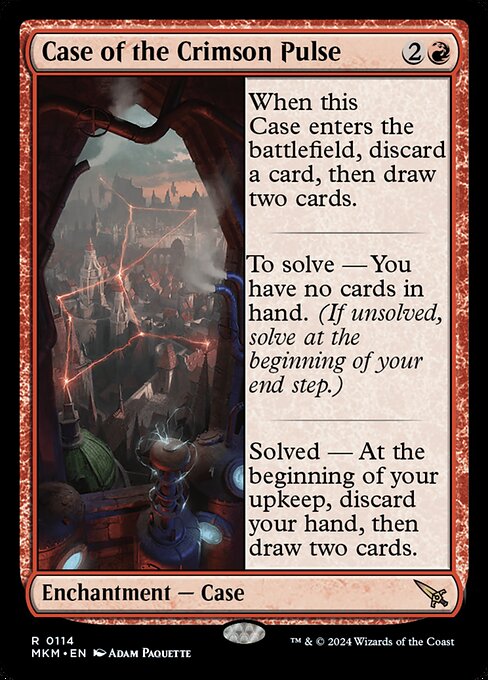
Image courtesy of Scryfall.com
Crimson Pulse Reprints and the Market Lifecycle
Red magic has always been a study in tempo, risk, and adrenaline, and Case of the Crimson Pulse embodies that ethos in card form. This Enchantment — Case from the Murders at Karlov Manor expansion drops onto the battlefield with a compact, two-color punch cost of {2}{R}, a familiar threshold for aggressive players and puzzle-lovers alike 🧙♂️🔥. The card isn’t just about a one-off play; it teases a broader lifecycle question that any MTG investor or casual collector contemplates: how does a reprint or a new printing influence supply, demand, and long-term value? The economics of reprints aren’t just about numbers; they’re about the story a card tells in your binder, on your dining room table, and in your local game store’s display case ⚔️🎲.
First, the text on this Case—“When this Case enters, discard a card, then draw two cards. To solve — You have no cards in hand. (If unsolved, solve at the beginning of your end step.) Solved — At the beginning of your upkeep, discard your hand, then draw two cards.”—reads like a designed mini-puzzle that rewards careful hand management. The red mana cost anchors it in a color known for tempo and explosive draws, while the transformative solve/sovled mechanic nudges players toward a longer-term plan: one cycle of decision-making that potentially refills your grip and reshapes the late-game tempo. It’s a clever example of how a single card can function as both a play engine and a flavor-driven artifact of its set’s mood 🎨.
From an economic lens, the lifecycle of a reprint hinges on several levers. Supply is the loudest drumbeat: a reprint dramatically increases available copies, often depressing floor prices for both foil and nonfoil versions. In contrast, demand grows with deck archetypes that discover the card’s utility—EDH enthusiasts or command-zone strategists who value cyclical card advantage and resilient draw-discard interactions may turn to a Case-like effect as a puzzle piece for hand-scrub parity and card filtering. For collectors, rarity matters. This card is a rare in Murders at Karlov Manor, and its initial print run, distribution, and foiling options help set its early foothold in the market. On Scryfall, current numbers show a nonfoil around $0.19 USD and a foil around $0.37 USD, with EUR prices a bit higher; these figures reflect a modern, budget-friendly corner of the market that could swing on a reprint or a prominent feature in a future set ❗💎.
What does this imply for players who chase value and for speculators watching market tides? In a hypothetical reprint scenario, the supply surge would typically push nonfoil prices down and foil prices read as a more stable premium due to foil scarcity and aesthetic appeal. Yet reprints can also introduce new variants or alternate frames that capture a different segment of the market. The lesson is simple: a reprint can reset the price curve, but a card’s core gameplay identity and its role in decks—especially in casual and Commander formats where puzzles and draws shine—can preserve a floor of interest that isn’t easily erased by a reprint. For Case of the Crimson Pulse, the interplay between discard and draw remains appealing for players who love misdirection and tempo games, and that enduring appeal gives it a lane in the market even when new printings arrive 🌟.
In practice, the card’s strategic niche is as important as its price tag. The initial entry drain-and-dettle moment on entry invites immediate value for the hand-declaration phase, while the solved state pivots the game to a hand-reset rhythm in upkeep. Decks that leverage wheel effects, hand-sculpting, or consistent card draw can weave this Case into a broader red-based strategy. The “solve” condition—having no cards in hand—creates a dynamic tension: you either bank the tempo with a careful discard and draw, or you reset more aggressively at upkeep. It’s a design puzzle that rewards planning and punishes sloppy mana/incidental draws. For players chasing synergy, this is a spicy piece that can anchor a control-red or midrange tempo shell, especially in formats that welcome interactive puzzles and recurring card advantage 🧠⚔️.
Design, art, and the vibe of a modern reprint lifecycle
Artist Adam Paquette lends a moody, noirish flourish to the Murders at Karlov Manor universe, and Case of the Crimson Pulse carries that atmosphere into its card frame and text. Theming a Case in a set simultaneously teases a mechanical curiosity and a story beat—your hand becomes a vault, then a gateway, then a reset button. The lifecycle of such a card in the broader market isn’t merely a numbers game; it’s about how players connect with the design philosophy: cards that reward anticipation, measurement, and puzzle-solving tend to retain a lasting place in both casual play and collector consciousness 🔮.
As you map out your collection or your next brews, consider how cross-promo opportunities, like the product linked below, fit into your lifestyle as a player and a fan. The practical side of MTG life includes carrying devices, managing sleeves, and keeping notes for those late-night league games—and a reliable phone stand can be a small but meaningful part of your gaming ritual. It’s the little ergonomic win that makes the hobby feel more enjoyable and organized, especially when you’re narrating a tense reprint discussion with friends 🧙♂️🎲.
phone-click-on-grip-portable-phone-holder-kickstandMore from our network
- https://crypto-acolytes.xyz/blog/post/g-bp-rp-magnitudes-reveal-a-hot-star-color-index-mystery/
- https://crypto-acolytes.xyz/blog/post/metamask-the-engine-behind-the-web3-economy/
- https://blog.digital-vault.xyz/blog/post/mtg-how-trustworthy-scout-shifts-creature-combat-math/
- https://blog.digital-vault.xyz/blog/post/lazotep-reaver-unveiling-phyrexian-palette-and-symbolism/
- https://crypto-acolytes.xyz/blog/post/famous-player-built-bases-in-survival-games/